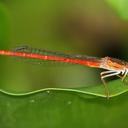United States and Canada
Males are bright red, including the eyes. There is black middorsal stripe one each side of the carina that widen abruptly at their posterior ends a nd then narrow again, so that combined they give the appearance of a posteriorly directed arrow. The majority of the remaining pterothorax and all of the abdomen is bright red. The cerci are no more than 2/3 the length of segment 10 and nearly uniform in height throughout their length. There are two black subapical medial teeth on each appendage, only the lower of which may be readily visible. The paraprocts are about four times as long as the cerci and with black apices. The females are marked like males, but tan in color. The abdominal segments 8-9 are black dorsally. The mesostigmal plates are subtriangular and only slightly sculptured.
Size: Total length: 25-31 mm; abdomen: 20-24 mm; hindwing: 13-17 mm.
Similar Species (south-central US): The ranges of Duckweed and Desert Firetails (T. salva) don't overlap in the region, which will help to differentiate these closely related species.
Habitat: Swampy, partially shaded areas with abundant floating duckweed.
Natural History: Although locally common in the southeast, it is rarely seen west of the Mississippi. The only known localities for this species in Texas are within the confines of Sam Houston National Forest where it has been taken on at least two different occasions. It has been reported from eastern Louisiana based on an early instar larva and sight records. It is also known from southern Arkansas. Adults apparently mature in forests some distance from aquatic habitats. They may be surprisingly inconspicuous perched on shady matted plants . They have a close association with duckweed, where the larvae live on the underside.
Distribution: Southeastern U.S. from Florida to Texas.
Source: Abbott, J.C. 2006-2010. OdonataCentral: An online resource for the distribution and identification of Odonata. Available at OdonataCentral.
Edited by Drew Weber (9/24/2015).
